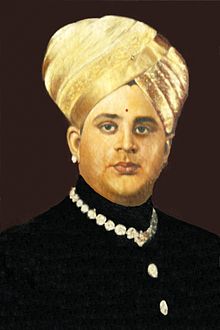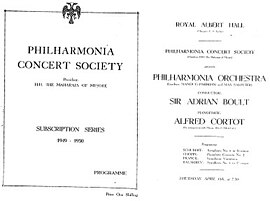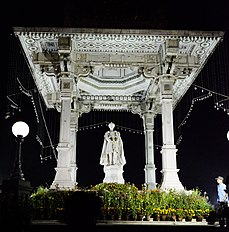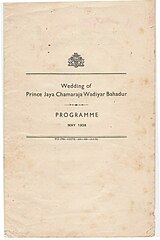Jayachamarajendra Wadiyar
| Jayachamarajendra Wadiyar | |
|---|---|
| Maharaja of Mysore | |
 | |
| 25thMaharaja of Mysore | |
| Reign | 3 August 1940 – 25 January 1950 |
| Coronation | 8 September 1940,Palace of Mysore |
| Predecessor | Krishnaraja Wadiyar IV(paternal uncle) |
| Successor | Srikantadatta Narasimharaja Wadiyar(son) |
| RajpramukhofMysore State | |
| In office 26 January 1950 – 1 November 1956 | |
| Preceded by | Position Established |
| Succeeded by | Position Abolished |
| GovernorofMysore State | |
| In office 1 November 1956 – 4 May 1964 | |
| Preceded by | Position Established |
| Succeeded by | S M Srinagesh |
| Governor of Madras State | |
| In office 4 May 1964 – 28 June 1966 | |
| Preceded by | Bhishnuram Medhi |
| Succeeded by | Sardar Ujjal Singh |
| Born | 18 July 1919 Mysore Palace,Mysore,Mysore State,India |
| Died | 23 September 1974(aged 55)[1] Bangalore Palace,Bangalore,India |
| Spouse | Satya Prema Kumari (m. 1938, div. 1940) Tripura Sundari Ammani (m. 1942) |
| Issue |
|
| House | Wadiyar dynasty |
| Father | YuvarajaKanteerava Narasimharaja Wadiyar |
| Mother | Yuvarani Kempu Cheluvaja Amanni |
| Religion | Hinduism |
Jayachamarajendra Wadiyar(Kannada:ಶ್ರೀ ಜಯಚಾಮರಾಜೇಂದ್ರ ಒಡೆಯರು;18 July 1919 – 23 September 1974), sometimes simplyJayachamaraja Wadiyar,was the twenty-fifth and last rulingMaharaja of Mysore,reigning from 1940 to 1950,[3]who later served as thegovernor of Mysoreuntil 1964 and asgovernor of Madrasfrom 1964 to 1966.
Wadiyar ascended the throne upon the sudden demise of his uncle MaharajaKrishnaraja Wadiyar IV.His reign as King began in 1940 during the onset ofWorld War IIinEuropeand concluded with his merging theKingdominto theDominion of Indiain 1947 but continued as maharaja untilIndia's constitution into a republicin 1950.[4]Kuvempu,his Kannada teacher and the vice-chancellor ofMysore University,remarked upon his ceding the kingdom: "Whereas kings have become so upon assuming thrones, he became a great king by renouncing one".[5]C. Hayavadana Rao, a noted historian, referred to the maharaja in the preface of his unfinished book as a "supporter of every good cause aiming at the moral and material progress of the people".[6]
Early life
[edit]Jayachamarajendra Wadiyar was born on 18 July 1919 atMysore Palaceas the only son and the last child of YuvarajaKanteerava Narasimharaja Wadiyarand Yuvarani Kempu Cheluvajamanni. He had three elder sisters: PrincessesVijaya Devi,Sujayakantha Devi, and Jayachamundi Devi.

Jayachamarajendra Wadiyar graduated fromMaharaja's College, Mysore,in 1938, earning five awards and gold medals fromMysore University.[7]He was married the same year, on 15 May 1938, to Maharani Satya Prema Kumari at the Palace.[8]He touredEuropeduring 1939, visiting many associations inLondonand became acquainted with many artists and scholars.
Reign
[edit]Accession
[edit]In March 1940, Jayachamarajendra Wadiyar lost his father Yuvaraja Kanteerava Narasimharaja Wadiyar who was second in line to the throne. Five months later, his reigning uncle,MaharajaKrishnaraja Wadiyar IVtoo expired, leaving his only nephew, Jayachamaraja Wadiyar, to succeed him to reign in what was dubbed one of the most prosperous states in Asia.[9]He ascended the throne of theKingdom of Mysoreon 8 September 1940 and was democratic in his administration, celebrated by his subjects as his uncle was. With the accession, he was inducted as afreemason.[10]
Ceding the kingdom
[edit]Jayachamarajendra Wadiyar was the first ruler to accede to merge his kingdom with the newly formed tentativeIndian UnionafterIndia's independencein 1947. He signed aninstrument of accessionwith the Union on the eve of India's attainment of independence on 15 August 1947. The result took three years to materialise owing to the drafting of aconstitution for the countryin the meantime.
With the constitution of India into a republic, the Kingdom of Mysore was merged with theRepublicon 26 January 1950. After the state wasabsorbedinto theDominion of India,he was granted aprivy purse,certain privileges, and the use of the titleMaharaja of Mysoreby theGovernment of India,[11]However, all forms of compensation were ended in 1971 by the26th Amendment to the Constitution of India.[12][4]
Wadiyar was made theRajpramukhofMysore Statein 26 January 1950. After theintegration of the neighbouring Kannada-majority partsof theMadrasandHyderabad States,the title was changed, and he became the firstGovernorof the reorganised Mysore State, from 1 November 1956 to 4 May 1964. He was later appointedGovernor of Madrasfrom 4 May 1964 to 28 June 1966.
Contributions
[edit]Sports
[edit]Wadiyar was a good horseman and a tennis player. He was also well known for his marksmanship and was highly sought-after by his subjects whenever a rogue elephant or a man-eating tiger attacked their immediate surroundings in and around the city of Mysore. There are many wildlife trophies attributed to him in thePalaceCollections.
Wadiyar is credited for financially supporting the tennis playerRamanathan Krishnanparticipate atWimbledon.[13]The maharaja also encouraged and aided the cricketerE. A. S. Prasanna's visit to theWest Indiesas his father was otherwise reluctant to send him.[14]
Literature
[edit]Wadiyar was aman of letters:he was an avid reader and writer and an acknowledged authority ofIndian philosophy.His literary works deal with a range of disciplines including administration, theology, history, civics, philosophy, administrative studies, among others.
Wadiyar sponsored the translation of many classics from Sanskrit toKannadaas part of the "Jayachamaraja Grantha Ratna Mala", including 35 parts of theRigveda.These are essentially ancient, sacred scriptures in Sanskrit which at that time were not available inKannada languagecomprehensively. All the books contain original text in Kannada accompanied by Kannada translation. As the courtier and astrologer Dharmadhikari H. Gangadhara Shastry, who himself contributed substantially in the above works, has stated, the Maharaja used to study each and every one of these works and discuss them with the authors.[15]
Wadiyar also encouraged historical research on modern lines; this finds an echo in the dedication of the encyclopaedic work entitledHistory of Mysoreby C. Hayavadana Rao published in three voluminous works published between 1943 and 1946.[6]
Selected literary works by the maharaja
[edit]- The Quest for Peace: an Indian Approach,University of Minnesota,Minneapolis 1959.
- Dattatreya: The Way & The Goal,Allen & Unwin, London 1957.
- The Gita and Indian Culture,Orient Longmans, Bombay, 1963.
- Religion And Man,Orient Longmans, Bombay, 1965 (based on Prof. Ranade Series Lectures organised atKarnataka Universityin 1961)
- Avadhuta: Reason & Reverence,Indian Institute of World Culture, Bangalore, 1958.
- An Aspect of Indian Aesthetics,University of Madras,1956.
- Puranas As The Vehicles of India's Philosophy of History,JournalPurana,issue #5, 1963.
- Advaita Philosophy,SringeriSouvenir Volume, 1965, pages 62–64.
- Sri Suresvaracharya,Sringeri Souvenir Volume,Srirangam,1970, pages 1–8.
- Kundalini Yoga,(a review of "Serpent Power"bySir John Woodroff)
- Note on Ecological Surveys to precede Large Irrigation Projects- Wesley Press, Mysore; 1955
- African Survey;The Bangalore Press;1955
- The Virtuous Way of Life–Mountain Path– July 1964 edition+23
- Aesthetic Philosophy of India– To be Published in 2024 by the Maharaja Shri Jayachamaraja Wadiyar Foundation!
Music
[edit]Wadiyar was a connoisseur of bothWesternandCarnatic classical music.As well as composing music himself, he also patronised numerous musicians in his court as well as international artists and became involved in acclaimed music organisations.
Western classical music
[edit]Wadiyar became aLicentiateof theGuildhall School of Music, Londonand honoraryFellowofTrinity College of Music, London,in 1945. Aspirations to become a concert pianist were cut short by the untimely deaths of his father in 1939 and his reigning uncle in 1940, when he had to succeeded to the throne.
Wadiyar became the first president of thePhilharmonia Concert Societyin 1948.[16]During his presidency, he founded the Medtner Society at London in 1948 in honour of the Russian composerNikolai Medtner.The maharaja also financed the recording of a large number of Medtner's compositions. Medtner dedicated histhird piano concertoto the maharaja. Maharaja wrote a personal letter on 20 Oct 1948 in which he said:
"I want particularly to let you know what real and genuine pleasure it has given me to listen to your glorious third piano concerto which it is my unique honour of having it dedicated to me. You will allow me to say that I consider your third concerto is possibly the greatest contribution made to the literature of the piano during the last half a century. I say so not because it happens to be dedicated to me, not because many other musicians and great critics have held it to be a work of the highest artistic standard, but beeause I as a layman have been deeply moved by its great spiritual feeling, its undertone of tragedy and sublimating all our" elan-vital "- like a Promethean will of victory over the darkness of our immediate horizons..."
Again on 28 Sept 1951 he wrote to his manager,Capt. Binstead: Medtmer is really a very remarkable man, amazing to the doctors themselves. His determination is as great as his talents. It is really a matter for admiration that Mr. Medtner has been able to finish the two songs, even at the time when he was on the verge of collapse. Really, God will grant him sufficient strength and health to be of immense service to the musical world - of which there is a real and great need at the present moment.. "
But sadly Medtner succumbed to his illness soon thereafter on 13 Nov 1951 and Maharaja cabled his wife thus: Nicholos great music will be immortal and that his name will live and shine as lustrous star is my firm conviction "!
Walter Legge,who was the record producer in these efforts, stated:
- "The visit to Mysore was a fantastic experience. The Maharajah was a young man, not yet thirty. In one of his palaces he had a record library containing every imaginable recordings of serious music, a large range of loud speakers, and several concert grand pianos... In the weeks I stayed there, the Maharajah agreed to paying for the recordings of the Medtner piano concertos, an album of his songs, and some of his chamber music; he also agreed to give me a subvention of 10,000 pounds a year for three years to enable me to put the Philharmonia Orchestra and the Philharmonia Concert Society on firm basis..."

This largesse proved sufficient to transform Legge's fortunes in 1949; he was able to engageHerbert von Karajanas conductor. The repertory the maharajah wished to sponsor wereBalakirev's Symphony,Roussel's Fourth Symphony,Busoni'sIndian Fantasy,etc.The association produced some of the most memorable recordings of the post-war period.
In 1950, Wadiyar sponsored an evening orchestra event at theRoyal Albert Hallby the Philharmonia Concert Society with German conductorWilhelm Furtwänglerin the lead and sopranoKirsten FlagstadsingingFour Last Songs,fulfillingRichard Strauss's last wish.
The maharaja was an equally good critic of music. When asked by Legge to pass judgement on the recent additions to theEMIcatalogue, his views were as trenchant as they were refreshingly unpredictable. He was thrilled by Karajan'sVienna Philharmonicrecording ofBeethoven'sFifth Symphony( "as Beethoven wished it to be" ), held Furtwängler's recording of theFourth Symphonyin high esteem, and was disappointed byAlceo Galliera's account of theSeventh Symphony,which he preferred Karajan had recorded. Above all, he expressed serious doubts aboutArturo Toscanini's recordings. "The speed and energy are those of a demon", he wrote to Legge, "not an angel or superman as one would ardently hope for". One of the reasons he so admired Furtwängler's Beethoven was that it was "such a tonic after Toscanini's highly strung, vicious performances".
In the July 1950 edition ofGramophone,Legge writes:
- ... Many more correspondent have written expressing their admiration for the vision, constructive enterprise, and generosity of the young Indian Prince who conceived this plan, and who is making it possible for the music lovers throughout the world to learn, enjoy and study works which but for his knowledge and love of music, would never have been recorded...
Carnatic classic music
[edit]After becoming Maharaja, he became increasingly exposed toCarnatic classical musicowing to the cultural vibrancy which prevailed in the Mysore court. He learnt to play veena underVid.Venkatagiriappa;he eventually mastered the nuances of Carnatic music under the tutelage of the veteran composer and courtierVid.Vasudevachar.The maharaja composed as many as 94 Carnatic music works under the assumed nameShri Vidya.All his compositions are in differentragasand some of them for the first time ever. He is credited with the creation of theragaJayasamvardini.[17]These compositions were published as a book in 2010 by R. Raja Chandra, his son-in-law, as "Sree Vidyaa Gaana Vaaridhi", edited by S. Krishna Murthy,Vid.Vasudevachar's grandson.
| Song | Ragam | Talam |
|---|---|---|
| Sri Mahaganapathim Bhajema(Sanskrit:श्री महागणपतिं भजेम) | Athana | Adi |
| Gam Ganapate Namaste(Sanskrit:गं गणपते नमस्ते) | Durvanki | Rupakam |
| Bhairavam Bhavayeham (Sanskrit:भैरवं भावयॆऽहम्) | Bhairavam | Adi |
| Maha Tripura Sundari Sankari mam pahi(Sanskrit:महा त्रिपुरसुन्दरी मां पाहि) | Kalyani | Jhampa |
| Kshria Sagara ShayanaVakshasthalaVasinim Pranamami(Sanskrit:क्षीर सागर शायन वक्षस्थल वासिनीं प्रणमामि) | Mayamalavagowla | Jhampa |
| Siva Siva Siva Bho Mahadeva Sambho(Sanskrit:शिव शिव शिव भो महादेव शंभो) | Nadanamakriya | Jhampa |
| Sri Guru Dakshinamurte Namostute(Sanskrit:श्री गुरु दक्षिणामूर्ते नमोस्तु ते) | Bhavapriya | Matya |
| Sri Jalandharam Asrayamyaham(Sanskrit:श्री जलन्धरं आश्रयाम्यहम्) | Gambhiranatta | Adi |
| Sri Rajarajesvarim Ashrayami(Sanskrit:श्री जाजराजेश्वरीं आश्रयामि) | Lalita | Rupakam |
| Vandeham shive(Sanskrit:वन्दॆऽहं शिवॆ) | Katanakutuhalam | Matya |
During these compositions, Wadiyar built three temples in Mysore city: Bhuvaneshvari Temple and Gayatri Temple, located inside the Mysore Palace Fort, and Sri Kamakaameshwari Temple, situated on Ramanuja Road, Mysore, all sculpted by his guru Siddalingaswamy.
Many noted Indian musicians received patronage at his court, includingMysore Vasudevachar,Veena Venkatagiriyappa,B. Devendrappa,V. Doraiswamy Iyengar,T. Chowdiah,Tiger Vardachar,Chennakeshaviah, Titte Krishna Iyengar, S. N. Mariappa, Chintalapalli Ramachandra Rao, R. N. Doreswamy, H. M. Vaidyalinga Bhagavatar.V. Ramarathnam,a veteran musician and scholar, authored the "Contribution and Patronage of Wadiyars to Music", a book that delves deep into the patronage and contribution of Wadiyars to Carnatic music.


Death
[edit]Jayachamaraja Wadiyar died at the age of 55 on 23 September 1974 at hisBangalore Palace;he was the last living person who had been the premier king of a state with a21-gun salute statusin British India. He was succeeded by his sonSrikantadatta Narasimharaja Wadiyaras the head of theRoyal Familyand the ceremonial maharaja of Mysore.
Family
[edit]Jayachamaraja Wadiyar married Maharani Sathya Prema Kumari ofJigni provinceon 15 May 1938. The marriage failed; the maharani returned to and settled atJaipur.There were no children by this marriage.
On 6 May 1942, two years into his accession as maharaja, Jayachamaraja Wadiyar married Maharani Tripura Sundari Devi. The couple has six children: Maharajakumari Gayatri Devi (1946–1974), who predeceased her father due to cancer;[18]Rajakumari Meenakshi Devi (b. 1951, d. 2015); YuvarajaSrikantadatta Narasimharaja Wadiyar(b. 1953, d. 2013); Rajakumari Kamakshi Devi (b.1954); Rajakumari Indrakshi Devi (b.1956); and Rajakumari Vishalakshi Devi Avaru (b. 1962, d. 2018).
Both the queens died in 1982 within a span of 15 days.
-
A public wedding pamphlet of Prince Jayachamaraja Wadiyar to his first wife Sathya Prema Kumari Devi
-
The Maharaja with his queen consort Tripura Sundari Ammani
Honours
[edit]
- Knight Grand Crossof the Most HonourableOrder of the Bath(GCB) in 1946
- Knight Grand Commanderof the Most ExaltedOrder of the Star of India(GCSI), 1945
Fellowships and memberships
[edit]- Fellow and president of theNational Academy of Music, Dance and Drama,New Delhi, 1966
- First chairman of theIndian Wildlife Board
Honorary doctorates
[edit]- Doctor of Literaturefrom theUniversity of Queensland,Australia.[1][2]
- Doctor of LiteraturefromAnnamalai University,Tamil Nadu.
- Doctor of LawfromBanaras Hindu University
- Doctor of Laws,honoris causafrom theUniversity of Mysore,1962
Memorials
[edit]- Hardinge Circle at Mysore was renamedJayachamaraja Circlewith the maharaja's life-size statue
- Jayanagar, Mysore,Jayanagar, Bangalore,andJayachamaraja Road, Bangaloreare named in the maharaja's honour
- Jaganmohana Palace at Mysore was renamedSri Jayachamarajendra Art Galleryin his memory
References
[edit]- ^"Jaya Wadiyar Bahadur Dies; Former Maharaja of Mysore".The New York Times.24 September 1974. Page 53, columns 4-6.Retrieved24 November2023.
- ^"Two members of erstwhile Mysore royal family die on final day of Dasara celebrations".19 October 2018. Archived fromthe originalon 19 October 2018.
- ^"Remembering the Maharaja who was a maverick, a genius".
- ^abSchmidt, Karl J. (1995).An atlas and survey of South Asian history.M.E. Sharpe. p.78.ISBN978-1-56324-334-9.
Although the Indian states were alternately requested or forced into union with either India or Pakistan, the real death of princely India came when the Twenty-sixth Amendment Act (1971) abolished the princes' titles, privileges, and privy purses.
- ^"'Elected representatives neglecting Wadiyars'".Deccan Herald.18 July 2018.Retrieved11 February2023.
- ^abRao, Hayavadana (1943).History of Mysore(PDF).pp. i.
- ^Trehan, Tanvi (18 July 2022)."Jayachamarajendra Wadiyar was a 'maverick maharaja' who ruled Mysore—and the world of music".ThePrint.Retrieved11 February2023.
- ^"Wedding Of Prince Of Mysore 1938".British Pathe News.Retrieved27 September2021.
- ^Rao, Conjeeveram Hayavadana (1930).Mysore Gazetteer.Government Press.
- ^"Masons offer hand, not handshake, in friendship".
- ^Ramusack, Barbara N.(2004).The Indian princes and their states.Cambridge University Press. p. 273.ISBN978-0-521-26727-4.
The crucial document was the Instrument of Accession by which rulers ceded to the legislatures of India or Pakistan control over defence, external affairs, and communications. In return for these concessions, the princes were to be guaranteed a privy purse in perpetuity and certain financial and symbolic privileges such as exemption from customs duties, the use of their titles, the right to fly their state flags on their cars, and to have police protection.... By December 1947 Patel began to pressure the princes into signing Merger Agreements that integrated their states into adjacent British Indian provinces, soon to be called states or new units of erstwhile princely states, most notably Rajasthan, Patiala and East Punjab States Union, and Matsya Union (Alwar, Bharatpur, Dholpur and Karaulli).
- ^"The Constitution (26 Amendment) Act, 1971",indiacode.nic.in,Government of India, 1971,retrieved9 November2011
- ^"The Last Great King".thisday.app.Retrieved19 April2023.
- ^"Kanteerava, the sports stadium in a lake bed".Hindustan Times.10 October 2022.Retrieved19 April2023.
- ^Praveen Kumar (18 September 2014)."Stolen: 82 rare tomes on ancient texts from Ramakrishna Math".Bangalore Mirror.Retrieved19 April2023.
- ^"10 facts about the Philharmonia".Archived fromthe originalon 18 May 2006.Retrieved3 December2006.
- ^"Jayachamarajendra Wodeyar Life, Music And Contributions".magzter.Retrieved30 January2023.[permanent dead link]
- ^Devi, Meenakshi (17 June 2007)."My daddy, His Highness, the Maharaja of Mysore".Deccan Herald.Retrieved15 January2014.
External links
[edit]- Kings of Mysore
- Wadiyar dynasty
- Hindu monarchs
- Knights Grand Cross of the Order of the Bath
- Knights Grand Commander of the Order of the Star of India
- Indian knights
- 1919 births
- 1974 deaths
- Maharaja's College, Mysore alumni
- Rajpramukhs
- 20th-century Indian poets
- Indian Freemasons
- Recipients of the Sangeet Natak Akademi Fellowship


